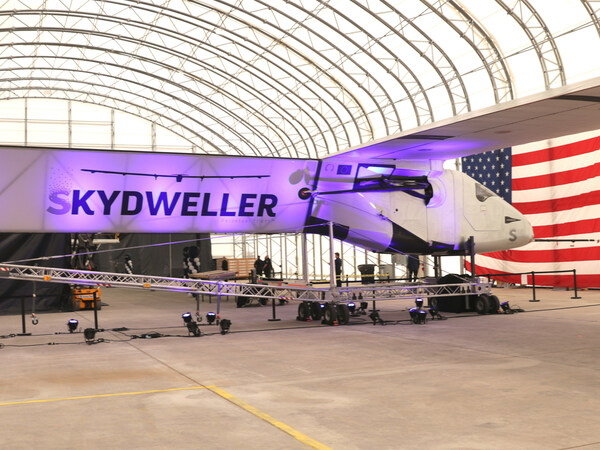Skydweller Aero Completes World's First Successful Unmanned/Uncrewed Flight of Large Scale Solar-powered Aircraft in the United States
Published by Todd Bush on April 4, 2024
KILN, Miss., April 4, 2024 /PRNewswire/ -- [Skydweller,](www.skydweller.aero) an uncrewed solar-powered aircraft which has a wingspan greater than a 747 and leaves zero carbon footprint, just completed the world's first successful autonomous/unmanned/uncrewed flight of a large solar-powered aircraft, taking off, flying and landing by itself, without humans on-board or in control, from Stennis International Airport in the United States.

Skydweller aircraft in hangar during unveiling event.
>> In Other News: Schneider Electric Announces Global Winners of Second Edition of Its Sustainability Impact Awards
"This is a true, world-changing first in the aerospace industry," said Robert Miller, CEO, Skydweller Aero, the aircraft's manufacturer, which is the only global manufacturer of large, autonomous solar-powered aircraft capable of perpetual flight. "Our fleet of uncrewed aircraft will enable a multitude of long-duration missions that support national security and non-terrestrial communications with revolutionary cost savings."
Skydwellers can be deployed for long-duration missions such as providing continuous aerial overage above conflict zones, surveilling naval activity in contested waters without risking pilots' lives, detecting drug smugglers and pirates at sea, and tracking wildlife migration and poaching in Africa.
"This really is a first when it comes to national security and protecting Americans," said Senator Roger Wicker, ranking member of the U.S. Senate Armed Services Committee who unveiled a Skydweller aircraft to the public last month. "It really is great news and it's only the beginning."
Skydweller aircraft are capable of perpetual flight, staying aloft for 90 days or more, at altitudes of up to 45,000 feet. In contrast, current combustion-powered aircraft, including piloted aircraft and drones, are limited to approximately 40 hours maximum flight time, limited by the endurance of pilots, the amount of fuel a conventional aircraft can carry, and the need for frequent maintenance.
"We are applying cutting-edge, 21st century materials science, artificial intelligence, and software development to an industry that has spent more than 100 years building piloted, combustion-based aircraft," Miller continued. "This allows Skydweller to leap ahead of heritage aircraft manufacturers in terms of aircraft performance, flight duration, and cost effectiveness."
Skydwellers can accomplish missions with a single aircraft that has historically required a fleet of conventional aircraft, flight crews and maintenance personnel. A single Skydweller aircraft capable of perpetual flight, coupled with minimal operating personnel, replaces all of this cost for the same mission. As such, solar-powered Skydwellers are 10 to 100 times less expensive to operate than conventional aircraft for long duration missions.
Furthermore, autonomous aircraft directly save lives by removing the need for flight crews to be physically present in hostile or dangerous airspace. For example, a Skydweller aircraft can take off from the United States, fly itself to the South China Sea, and stay in the air on mission for weeks or months before returning home. Additionally, autonomy enables not just traditional long-duration missions, but also new missions that would have formerly been deemed unacceptable due to risk to the flight crew.
About Skydweller Aero Inc.
Skydweller Aero Inc. is a pioneering transatlantic aerospace company developing and manufacturing a fleet of very large solar powered aircraft solutions capable of achieving perpetual flight with heavy, powerful payloads. Skydwellers are autonomous aircraft manufactured from carbon-fiber, each with a wingspan greater than a 747, and will be used for long duration missions such as providing continuous coverage above conflict zones, surveilling naval activity in contested waters, and detecting drug smugglers and pirates at sea. Because Skydwellers are solar powered, they are inexpensive to operate and maintain and feature zero carbon footprint. Skydweller Aero Inc., primarily backed by venture and private capital, has World and US headquarters in Oklahoma City and European offices headquartered in Spain.
With a flexible payload system, including communications relay, 4G/5G cellular, day/night full motion video, satellite communication, imaging radar, and more, Skydwellers will enhance commercial and government telecommunication, geospatial, meteorological and emergency operation efforts around the world, allowing customers to operate persistently in more challenging areas for longer durations, while reducing environmental impact. For more information about Skydweller, visit www.skydweller.aero.
SOURCE Skydweller Aero
Subscribe to the newsletter
Daily decarbonization data and news delivered to your inbox
Follow the money flow of climate, technology, and energy investments to uncover new opportunities and jobs.
Latest issues
-
Air Liquide Just Solved Hydrogen’s Hardest Problem
Inside This Issue ⚗️ Air Liquide's Ammonia Cracker Unlocks Hydrogen Trade 🤝 BASF and ExxonMobil Join Forces to Advance Low - Emission Hydrogen Through Methane Pyrolysis Technology 🔥 Haffner Energy...
-
Texas Bypasses EPA, Unlocks Billion-Dollar CCS Rush
Inside This Issue ⛽ Texas Bypasses EPA, Unlocks Billion-Dollar CCS Rush 🏭 Proposed Blue Ammonia Plant In Ingleside Moves Forward After Heated Debate 💡 Hydrogen Could Be The Secret To Unlimited Ene...
-
Spiritus Targets $100 Per Ton Carbon Capture Breakthrough
Inside This Issue 🌍 Spiritus Targets $100 Per Ton Carbon Capture Breakthrough 🌡️ Removing CO2 From Atmosphere Vital To Avoid Catastrophic Tipping Points, Leading Scientist Says 🛫 DG Fuels Appoints...
Company Announcements
-
Peaks Renewables Partners With Biogas Development to Expand Idaho Production
Peaks Renewables has teamed up with Biogas Development to enhance renewable gas production at the Hidden Hollow Energy Landfill Gas Project in Boise, Idaho. Peaks is making a preferred equity inve...
-
Funding led by Azolla Ventures with Chevron Technology Ventures and Freeflow Ventures positions Erg Bio to advance its cost-competitive bioindustrial platform as the U.S. prioritizes energy securit...
-
Plug Power Hosts Seventh Annual Symposium Highlighting Hydrogen’s Role in Energy Independence
SLINGERLANDS, N.Y., Nov. 18, 2025 (Globe Newswire) — Plug Power Inc. (NASDAQ: PLUG), a global leader in hydrogen solutions for the hydrogen economy, is hosting its seventh annual Plug Power Symposi...
-
NEWPORT BEACH, Calif. & OXNARD, Calif. (Business Wire) — Clean Energy Fuels Corp. (Nasdaq: CLNE) announced that it was awarded a contract to design and build a new hydrogen fueling station for ...